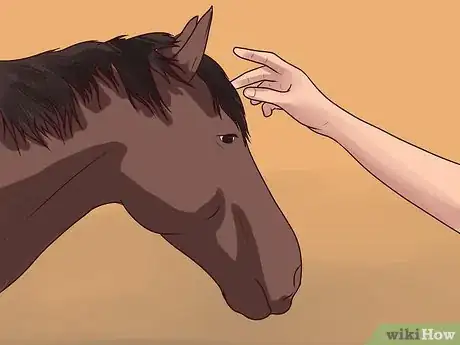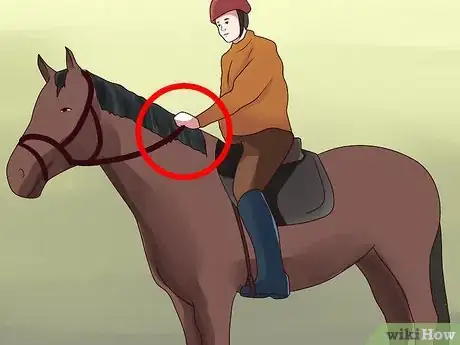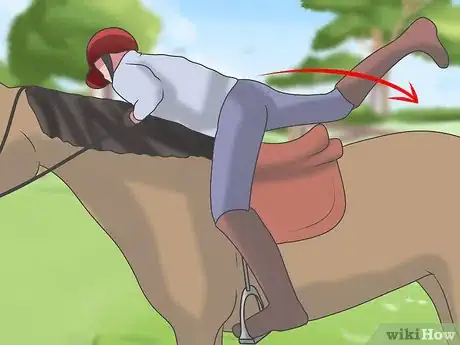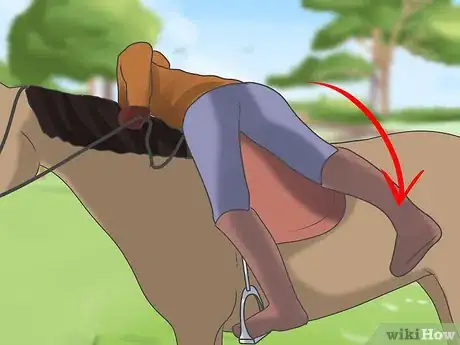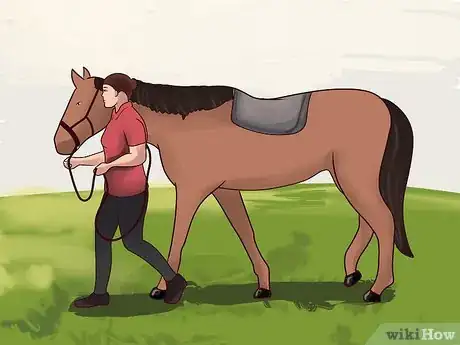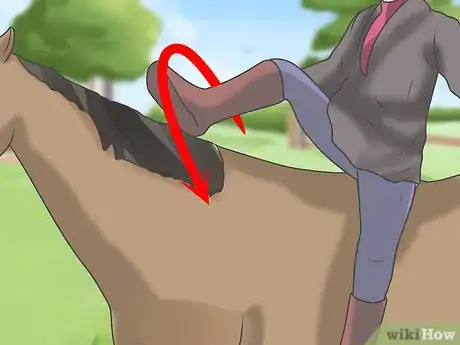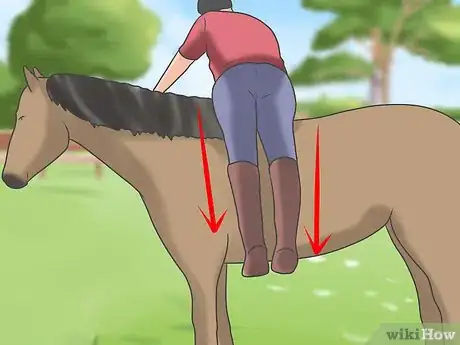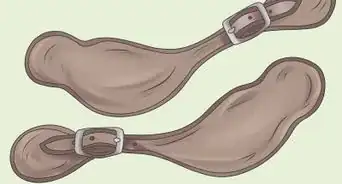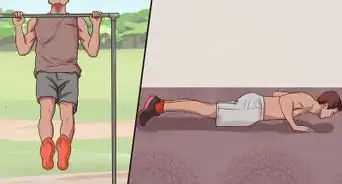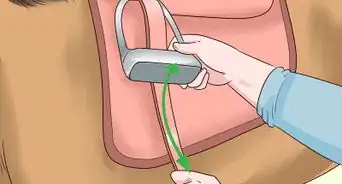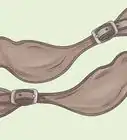wikiHow is a “wiki,” similar to Wikipedia, which means that many of our articles are co-written by multiple authors. To create this article, 21 people, some anonymous, worked to edit and improve it over time.
This article has been viewed 49,302 times.
Learn more...
Dismounting a horse can feel awkward the first few times, but it is not difficult to grasp the basics. As you practice, the movement will become faster and more fluid, making it safer for both you and the horse.
Steps
Dismounting from a Western or English Saddle
-
1Make sure the horse is still and calm. Never dismount until the horse has stopped moving completely.[1] If the horse is spooked or inexperienced, calm it before dismounting. Pat it gently and speak to it in a soft tone of voice until it becomes still. Shift your weight around slightly while you calm the horse, so it won't be surprised when you move to dismount.
-
2Hold the reins and mane in your left hand. Move both reins to your left hand. Keep holding them for the duration of the dismount, but take care to give them some slack and not to yank them suddenly. While holding the reins, grip the horse's mane. This will help stabilize you, and will not hurt the horse.
- Most horses are trained for dismounts on the left side, and may spook if you try to dismount on the right.
Advertisement -
3Remove your right foot from the stirrup. Stand up in the stirrups, gripping the saddle pommel with your right hand for balance if necessary. Tip your right toe down to remove your foot from the right stirrup. Continue immediately to the next step, turning it into one fluid motion.[2]
- If you are using an English saddle without a raised pommel, grip the front by curling your fingers under the front edge of the saddle instead. Also, you may be more familiar with the term "iron" in place of "stirrup."
-
4Pivot your right foot over the horse's rear. Learn your body forward over the front of the saddle, and bring your free right foot well up and over the rear of the horse, onto the left side. Be careful not to kick the horse's rear while you do so, as this can cause the horse to spook and start moving.[3]
- As you complete the motion with your right foot, you can move your right hand to grip the saddle's cantle (raised rear portion) for balance.
- While you may use your foot in the left stirrup for balance, do not push outward while you pivot. This could pull the horse and start it moving.
-
5Finish dismounting (one foot). There are two common ways to complete the dismount, each described in this section. To dismount on one foot, simply lower your right foot to the ground, keeping your left foot in the stirrup and your hands on the pommel and cantle (front and rear) of the saddle. Flex your knee slightly as you land to absorb the impact, make sure the horse is not moving, then use your right hand to lift your left foot out of the stirrup.
- You must be tall enough to reach the stirrup with your left foot from the ground. If you are not, you'll need to dismount onto a raised platform, or use the "both feet" method below.
- If you feel the horse start to move as you dismount, you can "bounce" up from the ground as you land and back into the saddle, to avoid falling. If you are not strong or experienced enough to do this, this method can lead to a dangerous situation.
-
6Finish dismounting (both feet). Alternatively, complete the dismount by pushing your left foot gently out of the stirrup as well, then sliding along the horse's belly to the ground. Complete this motion fluidly, without pausing, and flex your knees as you land.
- This dismount method can be performed from any height, and also carries no risk of getting your foot caught in the stirrup of a moving horse.
- Do not flail or shake your leg to get it out of the stirrup, as this could spook the horse. Instead, gently push against it, or pull up with your arms, to raise yourself higher, and lift your foot out.
-
7Lead the horse. Since you have held onto the reins this entire time, it is now easy to walk the horse from the ground. Before moving, put the stirrups up to prevent them knocking against the horse or getting caught on obstacles.
Dismounting from Sidesaddle or Bareback Riding
-
1Request assistance from sidesaddle. If you are riding sidesaddle, with both legs on one side of the horse, ask someone to help lift you down. Jumping down on your own often causes your clothing to snag on the tack, and makes it difficult to keep hold of the reins.
-
2Hop down from bareback. If riding bareback, one option is to bring your right foot over the horse's neck. Be careful not to hit your horse's neck as you do so, or it could easily spook. Once both feet are on the left side, hop down to the ground.[4]
- Do not attempt this from a saddle, as it is too easy to snare yourself in the tack.
-
3Slide down from bareback instead. Another bareback dismounting method is very similar to the dismount for western or english saddles. Swing your right leg clear over the horse's rump, then slide down the belly onto the ground. Since you have no saddle to hold onto, you will need to perform this motion quickly and fluidly to avoid unbalancing yourself.[5]
Community Q&A
-
QuestionI'm a bit overweight, am I still able to mount a horse from the ground? I tried and it worked, but the saddle moved, and I don't want to hurt the horse so much. I can't do it from the block, because my horse is terrified of it.
 Community AnswerConsider training the horse to get used to a block. Do it gradually, just walking past, and try to use other items, a bucket, steps, etc.
Community AnswerConsider training the horse to get used to a block. Do it gradually, just walking past, and try to use other items, a bucket, steps, etc. -
QuestionI've had hip surgery on my right side and don't have the ability to easily mount and dismount unless I use a very high mounting platform. Any suggestions to help?
 Community AnswerUsing a high mounting block is the best idea. You could also try lowering the stirrup before you get on.
Community AnswerUsing a high mounting block is the best idea. You could also try lowering the stirrup before you get on.
Warnings
- Always wear riding boots and long pants.⧼thumbs_response⧽
- Dismounting is often not a good idea in a dangerous situation, such as when the horse is shying or bucking. It is easier to control a horse from its back than from the ground, and it is difficult to dismount safely in these situations.⧼thumbs_response⧽
References
- ↑ https://www.dummies.com/sports/how-to-dismount-a-horse/
- ↑ https://esc.rutgers.edu/fact_sheet/mounting-dismounting-and-riding-horses-safely/
- ↑ https://esc.rutgers.edu/fact_sheet/mounting-dismounting-and-riding-horses-safely/
- ↑ https://www.youtube.com/watch?v=SWIRvEb1GgE
- ↑ https://www.youtube.com/watch?v=SWIRvEb1GgE
- ↑ https://practicalhorsemanmag.com/training/correct-safe-26802
About This Article
To dismount from a horse with an English or Western saddle, wait until the horse is completely still and calm. Hold the reins loosely in your left hand, then use that hand to grip the horse’s mane. Grip the saddle pommel or front edge with your right hand, then remove your right foot from the stirrup and pivot your right foot over the horse’s rear. Be careful not to kick the horse when you do this. Lower your right foot to the ground and remove your left foot from the saddle. To dismount from a horse that you’re riding bareback, keep reading!
